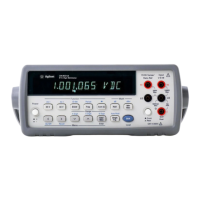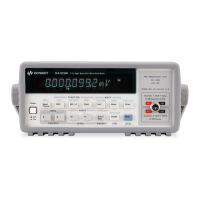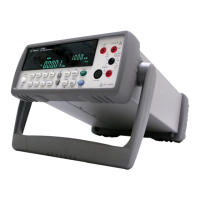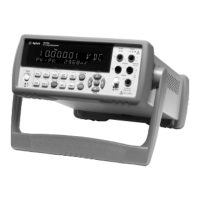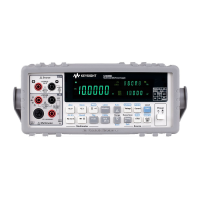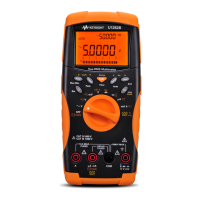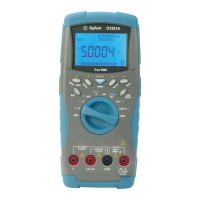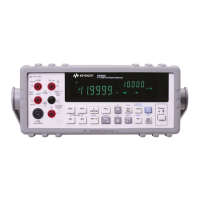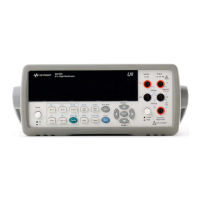Chapter 4 Making Measurements 109
The following program is an example of transferring readings from reading
memory to the controller at the fastest possible rate. The program stores 5000
readings in reading memory using the SINT format. The readings are
removed from memory using the "implied read" and transferred to the
controller (in the SINT format) using the TRANSFER statement (line 130).
The controller then retrieves the scale factor, multiplies the scale factor times
each reading, and stores the corrected readings in the Rdgs array.
10 OPTION BASE 1 !COMPUTER ARRAY NUMBERING STARTS AT 1
20 INTEGER Num_readings !DECLARE VARIABLE
30 INTEGER Int_rdgs(l:30000) BUFFER !CREATE INTEGER ARRAY FOR BUFFER
40 REAL Rdgs(l:30000) !CREATE REAL ARRAY
50 Num_readings=30000 !NUMBER OF READINGS = 30000
60 ASSIGN @Dvm TO 722 !ASSIGN MULTIMETER ADDRESS
70 ASSIGN Int_rdgs TO BUFFER Int_rdgs(*) !ASSIGN BUFFER I/O PATH NAME
80 OUTPUT @Dvm; "PRESET FAST" !TARM SYN,TRIG AUTO, DCV 10V
90 OUTPUT @Dvm;"APER 1.4E-6" !1.4µs INTEGRATION TIME
100 OUTPUT @Dvm; "OFORMAT SINT" !SINT OUTPUT FORMAT
110 OUTPUT @Dvm; "NRDGS"; Num_readings !30000 READINGS/TRIGGER, AUTO
115 !SAMPLE EVENT (DEFAULT VALUE)
120 TRANSFER @Dvm TO @Int rdgs;WAIT !SYN EVENT, TRANSFER READINGS INTO
121 !INTEGER ARRAY; SINCE THE COMPUTER'S INTEGER FORMAT IS THE SAME AS
125 !SINT,NO DATA CONVERSION IS NECESSARY HERE (INTEGER ARRAY REQUIRED)
130 OUTPUT @Dvm; "ISCALE?" !QUERY SCALE FACTOR FOR SINT FORMAT
140 ENTER @Dvm;S !ENTER SCALE FACTOR
150 FOR I=1 TO Num_readings
160 Rdgs(I)=Int_rdgs(I) !CONVERT EACH INTEGER READING TO REAL
165!FORMAT (NECESSARY TO PREVENT POSSIBLE INTEGER OVERFLOW ON NEXT LINE)
170 R=ABS(Rdgs(I)) !USE ABSOLUTE VALUE TO CHECK FOR OVLD
180 IF R>=32767 THEN PRINT "OVLD" !IF OVLD, PRINT OVERLOAD MESSAGE
190 Rdgs(I)=Rdgs(I)*S !MULTIPLY READING TIMES SCALE FACTOR
200 Rdgs(I)=OROUND(Rdgs(I),4) !ROUND TO 4 DIGITS
210 NEXT I
220 END
Determining the
Reading Rate
When using the TIMER sample event or the SWEEP command, the reading
rate is simply the reciprocal of the specified interval between readings
(assuming the TRIGGER TOO FAST error does not occur). For example, if
the TIMER interval is specified as lE-4, the reading rate is 1/l E-4 = 10,000
readings per second. When using another sample event, you can determine
the reading rate by specifying a large number of readings per trigger
specifying an output pulse after each reading (EXTOUT RCOMP
command), and connecting an electronic frequency counter to the
multimeter's Ext Out connector. The frequency displayed on the counter is
the reading rate expressed in readings per second.
Another method uses the controller to time a number of readings initiated by
the TARM SGL or TRIG SGL command. With the input buffer disabled
(INBUF OFF), the SGL event holds the GPIB bus until the readings are
complete. This means that the time required to execute the TARM SGL or
TRIG SGL command is the total time of the measurement. For example, the
following program stores readings in reading memory, times TARM SGL
for 10000 readings, divides 10000 by the total time, and displays readings
per second. The TIMEDATE command (lines 90 and 110) applies to
Hewlett-Packard Series 200/300 computers using BASIC language. Refer to
your computer operating manuals for more information on how to use you
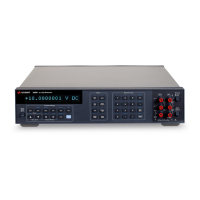
